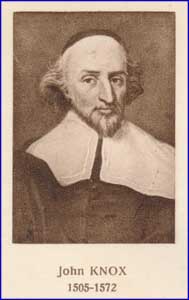The Lord’s Slave
by Rev. David T. Myers
 Were you, dear reader, aware that the man of the hour in Scotland, John Knox, once rowed a galley ship? No, it wasn’t for exercise. No, it wasn’t for some national pride of the fastest galley ship in a sailing contest. Simply put, John Knox was enslaved on that ship.
Were you, dear reader, aware that the man of the hour in Scotland, John Knox, once rowed a galley ship? No, it wasn’t for exercise. No, it wasn’t for some national pride of the fastest galley ship in a sailing contest. Simply put, John Knox was enslaved on that ship.
Some years earlier, Knox had entered St. Andrews Castle with three young children in tow. Their parents had entrusted him as a tutor. When events following the murder of a Roman Catholic cardinal went badly for anyone even remotely suspected of being part of that deed, Knox was urged to flee to that Protestant bastion for safety purposes. He was not one of the individuals who had killed the cardinal, but he did go there for safety. While residing at the castle, the chaplain to the soldiers at the chapel was urged by the congregation to extend a pastoral call to Knox, recognizing his spiritual gifts. At first, Knox resisted, but finally gave in to the invitation. He began to preach boldly on themes familiar to the Protestant reformation then beginning in the land of Scotland.
At the end of June in 1547, the French fleet besieged St Andrews Castle. On this day, July 31, 1547, the French gained victory over the defenders inside the castle walls. Promises were given to spare their lives, and an offer made to enter the service of the French king, but if declined, then they were to be conveyed to any country they wished, provided it was not Scotland. Upon arrival in France, immediately the terms of surrender were annulled, and they became prisoners of war. John Knox became a galley slave for nineteen months.
While there were months in which the slave ship did not sail due to weather and cold conditions, in warmer months Knox labored under cruel conditions, of which he writes in many a book and sermon afterwards. He was loaded with chains. He spoke of the sobs of his heart during the imprisonment, in great anguish of mind and vehement affliction. These were the torments he sustained in the galley ship.
Amidst all of the physical mistreatment, there came also attacks upon their faith. Daily, the Romanist mass was offered, with expected reverence by the prisoners. As soon as it began however, the galley slaves would cover their heads so they wouldn’t hear the words of the service. Daily, there were efforts to get the prisoners to confess the Romanist faith. Once, a figure representing the Virgin Mary, was pressed between the chained hands of a slave, with a command to kiss the figure. The slave, who many believer to be John Knox himself, threw the figure overboard into the sea, loudly proclaiming the Virgin to save herself by swimming! After this, there were no more attempts to convert the prisoners.
John Knox gradually wore down physically from this experience, with a fever near the end of it. Rowing close to the Scottish coast, they raised the feverish Reformer up when the spires of St. Andrews came into view, asking him if he recognized it. He answered, “I know it well; for I see the steeple of that place where God first opened my mouth in public to his glory; and I am fully persuaded, now weak I now appear, that I shall not depart this life, til my tongue shall glorify His godly name in that same place.”
Whatever means was used (and even Thomas M’Crie was not sure what it was), after 19 months in harsh conditions, John Knox was freed and he returned to continue his ministry in England and Scotland.
Words to Live By:
It wasn’t God’s will that Knox should be kept forever as a galley slave. It was God’s will to free him so as to allow him to continue his ministry in the Reformation. All of us ever live within the scope of God’s will throughout all our lives. Let us submit to that will, in large areas as well as small areas.

No comments
Comments feed for this article